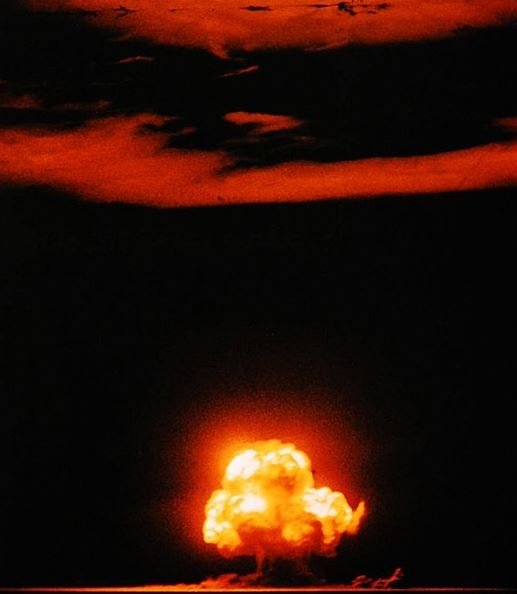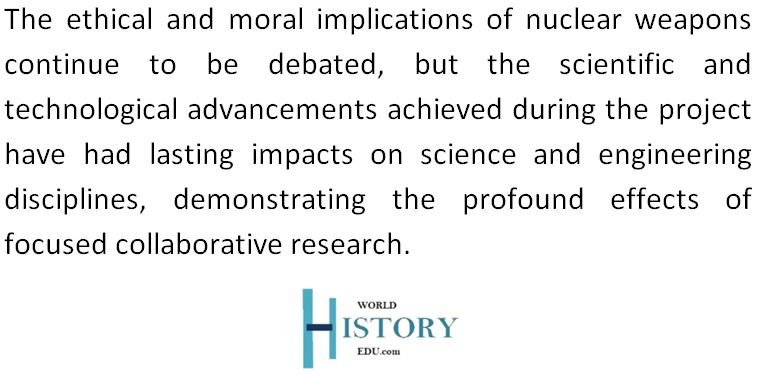Timeline of the Manhattan Project
The Manhattan Project, one of the most significant scientific endeavors of the 20th century, was an extensive research and development project that produced the first nuclear weapons during World War II. This project involved large-scale collaboration among physicists, chemists, engineers, and military personnel, and was carried out under a shroud of secrecy.
Below, WHE presents a detailed timeline covering key events and developments in the Manhattan Project:

The Manhattan Project was a monumental scientific and engineering achievement that not only ended World War II but also ushered in a new era in warfare and energy. Image: Picture of the first nuclear test explosion. It was taken by US photographer and physicist, Jack Aeby.
1938-1939: Discovery of Nuclear Fission
- December 1938: Otto Hahn and Fritz Strassmann, German chemists, discover nuclear fission, the process of splitting atomic nuclei.
- January 1939: News of Hahn and Strassmann’s discovery reaches the United States, where physicists, including Niels Bohr and Enrico Fermi, discuss its implications, particularly the possibility of a chain reaction releasing enormous amounts of energy.
1939: The Einstein-Szilard Letter
- August 1939: Concerned by Nazi Germany’s potential to develop atomic bombs, physicist Leó Szilard and colleagues draft a letter to President Franklin D. Roosevelt, warning of the implications of uranium research. Albert Einstein signs the letter, which urges the U.S. government to start its own research.
1941: The MAUD Report
- July 1941: The MAUD Committee in Britain confirms that a bomb is feasible with uranium-235. The report reaches U.S. officials, leading to increased urgency and funding for American research.

1942: Project Development
- January 1942: Roosevelt approves the project, now code-named the “Manhattan Project”, for expanded research.
- September 1942: Colonel Leslie R. Groves of the U.S. Army Corps of Engineers is appointed to lead the project. He recruits Robert Oppenheimer as the scientific director.
- December 1942: The first controlled nuclear chain reaction is achieved under the stands of Stagg Field at the University of Chicago, directed by Enrico Fermi.
1943: Expansion and Construction
- 1943: The project expands across multiple sites. Key locations include Oak Ridge, Tennessee (uranium enrichment), Hanford, Washington (plutonium production), and Los Alamos, New Mexico (weapon design and assembly).
- April 1943: Construction begins on the massive K-25 gaseous diffusion plant at Oak Ridge for uranium enrichment.
- August 1943: Quebec Agreement is signed by Roosevelt and Churchill, formalizing cooperation between the U.S. and Britain.
1944: Production Begins
- 1944: Hanford’s reactors begin producing plutonium. Difficulties with plutonium production are addressed, and the first, small amounts of plutonium are sent to Los Alamos.
1945: Testing and Deployment
- April 1945: President Roosevelt dies; Harry S. Truman becomes president and is briefed on the project.
- July 16, 1945: The Trinity Test, the world’s first nuclear explosion, occurs at Alamogordo, New Mexico. The test confirms that the implosion-design plutonium bomb is viable.
- August 6, 1945: The uranium gun-type bomb, “Little Boy”, is dropped on Hiroshima, Japan.
- August 9, 1945: The plutonium implosion bomb, “Fat Man”, is dropped on Nagasaki, Japan.
Post-War Period
- August 1945: Japan surrenders, effectively ending World War II. The devastating power of nuclear weapons becomes a pivotal point in military and ethical discussions worldwide.
- 1946: The Atomic Energy Act is signed by President Truman, which transitions control of atomic energy from military to civilian hands, marking the beginning of “atomic age” governance.

Frequently asked questions about the Manhattan Project
These questions cover the essentials of the Manhattan Project’s history, objectives, and impacts.
When did the Manhattan Project start and end?
The project officially began in 1942 and ended in 1946. It was initiated after discoveries in nuclear physics that suggested the possibility of a nuclear bomb.
Who led the Manhattan Project?
The project was led by U.S. Army Brigadier General Leslie R. Groves and scientific director J. Robert Oppenheimer.

The Manhattan Project was a research and development project during World War II that produced the first nuclear weapons. It was led by the United States with the support of the United Kingdom and Canada. Image: Leslie Groves.
Why was it called the Manhattan Project?
The project was named after the Manhattan Engineer District of the U.S. Army Corps of Engineers, because its initial operations were located in Manhattan, New York.
What were the main sites of the Manhattan Project?
Major sites included Oak Ridge, Tennessee (uranium enrichment); Hanford Site, Washington (plutonium production); and Los Alamos, New Mexico (weapon design and assembly).
What was the Trinity Test?
The Trinity Test, conducted on July 16, 1945, in New Mexico, was the first successful detonation of a nuclear weapon and served as a test for the implosion-type bomb.
What were the names of the bombs developed during the Manhattan Project?
The project developed two types of bombs: “Little Boy,” a uranium gun-type bomb, and “Fat Man,” a plutonium implosion-type bomb.
How did the Manhattan Project impact World War II?
The project led to the development of nuclear bombs that were dropped on the Japanese cities of Hiroshima and Nagasaki in August 1945, leading to Japan’s unconditional surrender and the end of World War II.
What was the cost of the Manhattan Project?
The project cost approximately $2 billion at the time (about $28 billion in today’s dollars), making it one of the most expensive military projects.
What were the ethical implications of the Manhattan Project?
The use of nuclear weapons on Hiroshima and Nagasaki raised profound ethical questions about civilian casualties and the future implications of nuclear warfare.
























